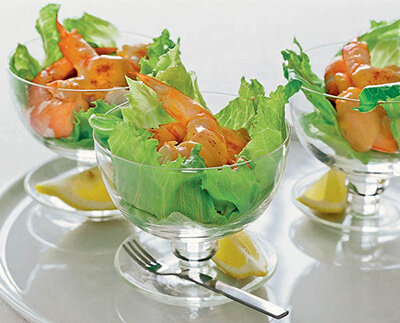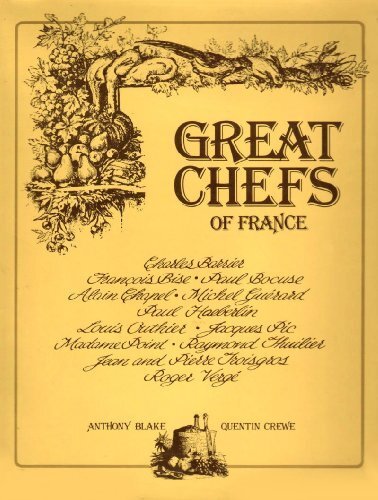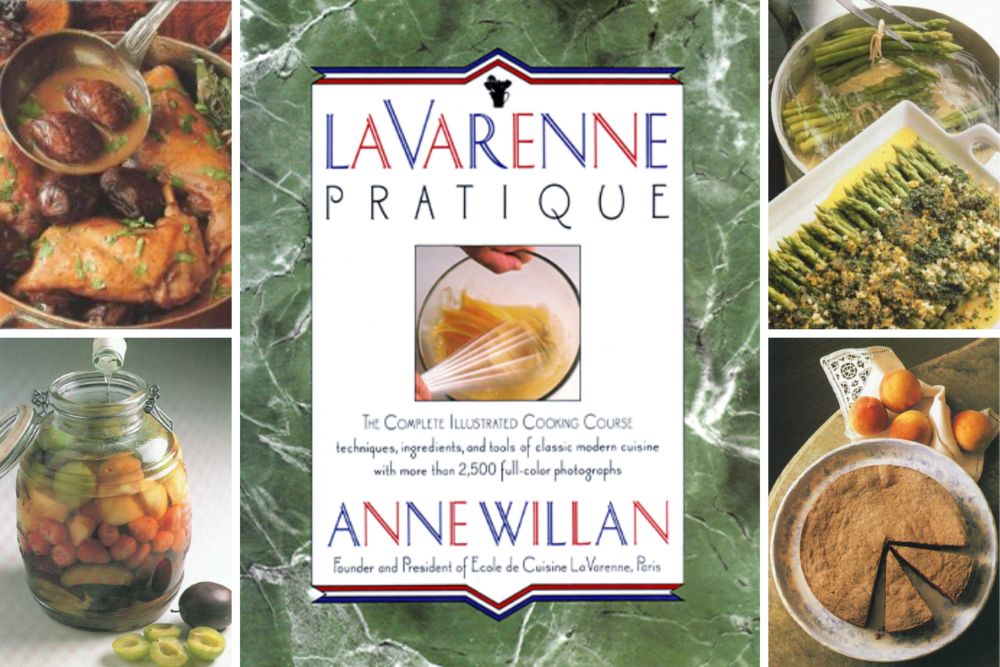Advertisement
Behind the Cookbook: Great Chefs of France
13 July 2021 · Behind the Cookbook
“The necessary ingredients which make up a superb restaurant, as opposed to merely a good restaurant, are as indefinable and as complex as those which are needed to make an attractive human character” writes Quentin Crewe in Great Chefs of France. Published in 1978, his wonderful book takes the reader on a trip to meet the larger-than-life characters of 13 rural restaurants that held three Michelin stars in the mid-1970s.
Crewe and photographer Anthony Blake produced this gastronomic bible over the course of two six-week journeys. It is a unique snapshot of the heyday of haute cuisine and a glimpse into the lives of the chefs, their philosophies and what made them tick. Crewe was a writer, journalist and restaurateur who despite being confined to a wheelchair for most of his life traveled far and wide. He was the fourth westerner to cross the Rub' al-Khali desert (‘the Empty Quarter’) of Saudi Arabia. His inimitable style of writing has had a lasting influence on restaurant criticism.
Crewe’s daughter Candida (herself a writer) reflects on the life of her father, who loved her, loved food, and loved life, and how he came to pen what many chefs regard as one of the best books on French cuisine ever written.
“It’s a book of dreams.”
By Candida Crewe
The inscription in my tatty but precious copy of Great Chefs of France in my late father’s inimitable hand reads, “To Candida – in the hope that one day she will like some sauce other than tomato ketchup.”
The book was published in 1978 and was, chef Marco Pierre White told me, the inspiration when he was 17 for his chosen career and dream to gain three Michelin stars. “Great Chefs of France is without question the greatest book ever published within the world of gastronomy,” he says. “It’s a book of dreams.” It was/is a favorite of Anton Mosimann, Heston Blumenthal, Gary Rhodes, Rowley Leigh, Jeremy Lee and the Galvin Brothers, among many others. An acknowledged classic, it unsurprisingly took a while to produce.
I must have been 11 or 12 when the photographer, Anthony Blake, approached my dad to write the text about the 13 Michelin three-star restaurants in rural France at the time (there were 18 altogether then, but five were in Paris).

Marco Pierre White described Great Chefs of France as “the greatest book ever published within the world of gastronomy”.
The inventor of modern restaurant criticism
Dad was “the inventor of modern restaurant criticism” according to restaurant critic Fay Maschler. He had become one by chance. He was working at Queen magazine in the 1960s, and the restaurant reviewer was ill. Dad told the editor he was lunching at Wilton’s that day, so might as well write about it. He did so in his own inimitable style and landed the permanent gig, before moving on to do so at The Evening Standard.
Astonishingly, before he began writing about restaurants, no critic had ever actually criticized a restaurant’s food, apparently. Nor had they described the room, the waiters, the fellow diners, the atmosphere. It was Dad who decided to describe the whole experience of eating in a restaurant like theatre. It is a style we completely take for granted today, but one that made him the perfect choice as the author of The Great Chefs.
When I was a child, there was no greater treat than being taken to a restaurant with him, more often than not at a traditional Italian place on the Fulham Road, with linen tablecloths, grissini in wax paper sleeves and, on the menu, always, prawn cocktail and Pollo Supriso. I never chose anything else. That, to me, was food at its poshest. At home with my mother, she was the queen of traditional English puddings and, when I stayed with Dad, my stepmother cooked wonderful roast chicken and Peking duck. Food did not get better than theirs.

Prawn cocktail: “Food at its poshest”?
As Dad was planning his trips to France to meet and interview the world-famous chefs, he tried to describe to me the food that he would be eating and writing about. I could not even begin to understand what he was getting at. I only knew filthy school pap and the simple but delicious dishes that my mother and stepmother produced. The concept of the recipes in the great chefs’ repertoire was beyond my imagination and I don’t think that was just because I was a child. At the time, their haute, haute, haute food was almost certainly beyond the ken of most people on the planet.
My father became very impatient with my ignorance and inability to comprehend even the idea of Roger Vergé’s Le Foie Gras d’Ote au Vinaigre de Jerez, avec Les Haricots Verts Fins à L’Echalotte or the Loup en Croûte de la Méditerranée Sauce Choron by Paul Bocuse. But he didn’t have much of a leg to stand on because he was a useless cook himself, so he wouldn’t have had much of a clue – before he went on his trips and interviewed these culinary gods – as to how on earth these astonishing dishes were put together. Once, aged 5, I asked him how to heat a tin of baked beans. He scoffed, “How do you think, you idiot? Just put it in a pan of boiling water!”
“Strong, greedy young man required”
But he was able to write about food like none other. When he was commissioned by his publisher, he placed an ad in the Times, which read: “Strong Greedy Young Man required by disabled Author to visit gastronomic Meccas of France.”
In 1932, when Dad was six years old, a creepy Harley Street doctor told his mother he had muscular dystrophy and that he’d be dead by 17. And told him he’d be cured. Certainly, he carried on with his life precisely as if there was nothing the matter with him, going in for marriages – several; children – numerous; and far-flung adventures – always. I never saw him walk. Still, he had this knack of making his wheelchair invisible, and he lived fully until 1998, when he died aged 72.
Some 150 applicants replied to his ad, one of whom was the slim, handsome 23-year-old Piers Russell-Cobb. He landed the job. This was thanks to my beloved sister Charity, who was seduced by his voice on the telephone. She was six. Dad was taken by his appearance, that of “an unpolished, overgrown schoolboy.” Mistakenly, as it turned out. He soon discovered his love life had “the complexity of a multinational corporation.”
To make this book, the unlikely pair set off to France together for six weeks – twice. Every day they had to eat multi-course lunches and dinners. Piers complained he put on two stone – and four decades later, stone one and stone two are both still loyally hanging on in there.
To make their job easier, they were fortunate to come upon a great pill called Festale, the size of a horse drench and made of ox bile. One a day made it possible, supposedly, to eat twice as much.
But even Festale was not enough in the face of the great master, Paul Bocuse. He was the one who broke them. Following a breakfast-time wine tasting with breeze blocks of foie-gras, he invited them to a six-course lunch and then on to dinner. After weeks of 20 courses a day, they were green as algae on the way to the restaurant that evening.
With much French fanfare, the gastronomic god produced some mussel and saffron soup, a 6lb Poulet de Bresse, a mountain range of cheeses and a tarte aux fruits the size of a Ferris wheel. His two English guests were smelling defeat. Dad managed one bite and stealthily passed all the rest to Piers.
“Your job,” he hissed at him, “is greed. Eat!”

“Paul Bocuse has leadership in full measure. For nearly all the chefs in this book, he is the chief.” Great Chefs of France.
They were both groaning like roadkill. “Difference was,” Piers told me, “I was the one being called upon to defend the honour of this great gastronome.”
So, young hero that he was, he consumed the whole bloody bird, stripped it to the bones like Asterix. One man, two dinners. Meanwhile, Quentin, having got away with a single morsel, gradually began to return to his normal colour. Spent the last part of the evening relaxing with Bocuse, happily reminiscing about gastronomic affairs. Poor, pitiful Piers, not so much. He was delirious.
On the way back to the hotel that evening, Quentin turned to his wretched companion, who was weak at the steering wheel. And just as Dad did at the end of every victory, great or small, he said in his singular, triumphant tone:
“Let’s go dancing!”
A selection of recipes from chefs featured in Great Chefs of France
Find all the recipes from Great Chefs of France in full, on ckbk.
Sign up for ckbk's weekly email newsletter
More tales of French food
Advertisement






